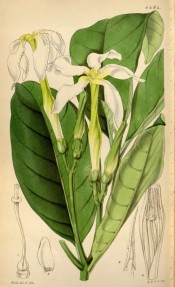Tabernaemontana longiflora Benth.
Frost tender tree with oblong-eliptic leaves and cymes of usually 3 large, long-tubed, clover-scented white flowers in summer. [RHSD].
Horticultural & Botanical History
Introduced to Britain in 1849. [JD]. ‘A new and valuable acquisition to our stoves, recently imported by Messrs. Lucombe, Pince, and Co., Exeter Nursery, from Sierra Leone, through Mr. Whitfield. The shrub has close-placed, ample, dark green foliage, and remarkably large white or pale cream-coloured flowers, diffusing a delicious aromatic fragrance, resembling that of cloves. Dr. Vogel, who also found the plant at Sierra Leone (as did Heudelot at Senegambia), speaks of this shrub as very handsome, with the aspect of a Citrus and yielding a milky juice. […] A tropical shrub, requiring a warm stove. It will thrive in a mixture of loam and peat soil, if placed so as to have the benefit of bottom heat, and watered and syringed freely during the summer; but care should be taken that at no time (especially during its season of rest) the mould becomes saturated; for the soft and slightly succulent roots are apt to suffer if kept in too wet a state while the plant indicates a cessation of growth; and during that period it should be removed to a drier atmosphere. It will strike from cuttings placed under a bell-glass, and treated in the usual way for the propagation of tropical woody plants.’ [BM t.4484/1849].
History at Camden Park
The only record is a handwritten entry in an 1850 catalogue held at the Mitchell Library and inscribed on the front Wm. Macarthur 23rd Dec. 1854. [ML 635.9m]. This is good evidence that it was grown in the gardens at this time although it didn’t appear in the 1857 edition of the catalogues.
Notes
Tabernaemontana longiflora Rusby is a tropical American species described in 1920.
Published Jun 03, 2009 - 02:55 PM | Last updated Jul 14, 2010 - 12:24 PM
| Family | Apocynaceae |
|---|---|
| Category | |
| Region of origin | Sierra Leone |
| Synonyms | |
| Common Name | |
| Name in the Camden Park Record | Tabernaemontana longiflora |
| Confidence level | high |


